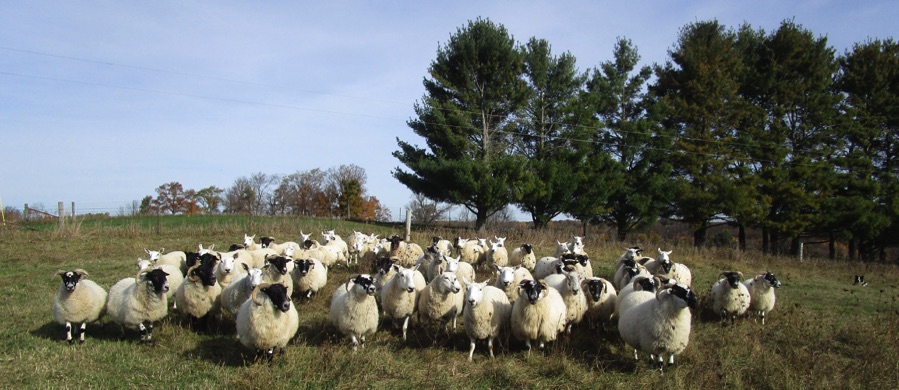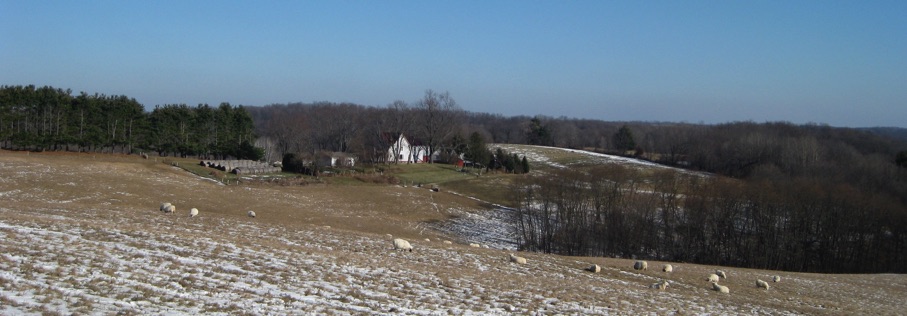


A Year at Littledale
We currently raise purebred registered Scottish Blackface and registered North Country Cheviot sheep, plus crossbred lambs for market sired by a North Country Cheviot ram. These breeds are hardy hill sheep breeds and do not require or desire a lot of intensive management -a helping hand and diligent shepherding is the management style that we have developed. We could not efficiently manage these sheep without the assistance of well trained border collie herding dogs.
January
The sheep are fed hay free choice from large bale feeders. The hay is a mixed grasses and clover mix. The bale feeders are placed in or around the barnyard and the sheep also have access to pasture. Salt and minerals and fresh water are provided. The sheep do not have access to the barn, but the barn building provides shelter.
February
Same management as in January, plus all the sheep, including the rams, are given 2cc booster vaccination of Covexin-8.
March
Same management as January except the barn is made available to the sheep because lambing starts in the middle of the month. The ewes are given protein lick tubs to provide extra energy for lambing. The gates to the pasture are closed in mid month so that all the lambs are born in the barn or in the barnyard area. Ewes and lambs are confined in individual lambing pens for approx 3 days to promote bonding. At this time we make sure that the ewe has adequate milk and that the lamb(s) is (are) feeding. The ewe is fed hay and plenty of water. While in the lambing pens the lambs are given 1cc Bo-Se (selenium supplement), administered sub-q, and are given number tags. The tails are docked with an elastrator to a length to cover the anus/vulva -we put the band just below where the wool starts to grow on the underside of the tail. We castrate the crossbred ram lambs -again with the elastrator. We do not castrate purebred rams. The ewes are wormed (with Cydectin currently) before we turn them and lambs out into a large mixing pen. The pen holds approx. 6-8 ewes and their lambs and they are kept in there together until the lambs are 5-6 days old and are totally bonded with their mothers. A creep feed area adjoins this mixing pen and the lambs have access to creep feed, although we do find that our breeds of sheep do not start eating much creep feed until they are about a month old. The creep area has a light which is kept on day and night and we find many of the lambs go in there and sit together. The older lambs have access to the area from the main barn. We feed a commercial lamb feed as creep feed- 15% protein. The lambs always have access to hay and water and salt and minerals.
April
The lambing usually continues until the second week of April. When all the ewes have lambed, and the pasture is growing, we gradually withdraw the lick tubs.
May
The pasture should be starting to grow this month and the gates are opened for the sheep to browse. Creep rations are continued for the lambs but we find they prefer the grass and by the end of the month the barn is closed and the sheep are out on pasture full time. We have the sheep sheared about the middle of May or early June, before the days start to get very hot. The feet of the rams are trimmed at shearing, because we have extra help and they are also wormed at this time. The ewes feet are trimmed on an as-needed basis.
June
The sheep are maintained on pasture with fresh water and salt and minerals provided. Lambs are given CD & T shots and all the flock is checked for worming towards the end of the month.
July
The sheep are still on pasture. Towards the end of the month we evaluate all the lambs and decide which are to be kept as breeding stock and which will go to market. We market our lambs as feeder lambs -they need to be 55lbs or more. Some may go at the end of the month. Lambs and ewes are continually monitored for signs of worms and are dosed as needed. We avoid dosing ewes if it is not necessary.
August
Lambs are sent to market as they are ready and breeding stock is sold. All remaining lambs are weaned from the ewes and the ewes are examined for any udder problems. The flock is moved between pastures to gain the most feed from our fields.
September
The sheep are still on pasture and pasture management is critical so as to save enough grass in the several different pasture paddocks that are used for breeding next month. All the sheep are evaluated and any culling decisions are made this month. Replacement lambs are vaccinated with 5cc of Covexin-8, followed by a 2cc booster 6 weeks later. Cull ewes and the last of the lambs are sent to market or the locker. The remaining breeding flock is wormed as necessary.
October
The ewes and rams are put onto good pasture for the first two weeks of the month and then separated into breeding groups in late October/early November. (lambing will be scheduled to start about March 21). The replacement lambs are not bred their first year and are kept separately. Any remaining market lambs are sent to the locker
November
The breeding continues until approximately the third week when the rams are taken from the ewes. The rams are put into very close confinement in a small shed for about 5 or 6 days until they get to know each other again! This prevents them from doing too much damage to each other when they vie for the top ram position! The ewes are still on pasture but are given access to large hay bales if there is snow on the ground. Fresh water is always available and we keep a heater in the tank. The rams are maintained separately with hay, fresh water, salt and minerals and have access to pasture all winter long, with an open fronted shed available for shelter.
December
Sheep are maintained as in January. We currently have 28 breeding ewes and they eat 2 large (1200+ lbs) bales of hay every 10-12 days, so the consumption is approx 4lbs of hay per day. The smaller group of replacement yearling ewes consume a large bale every 2-3 weeks. The rams consume slightly more because they weigh more!

